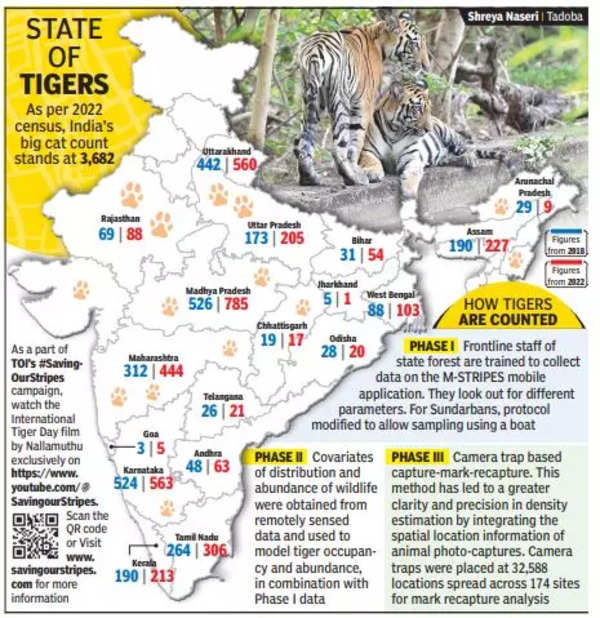India’s tiger population goes up, and M.P. has most big cats
Context:
According to a projection presented on Saturday, India’s tiger population will expand to 3,682 from 2,967 in 2022. This is an increase from April, when the Wildlife Institute of India (WII), which oversees the quadrennial tiger census, predicted a minimum of 3,167 animals.
Project Tiger:
- The Government of India initiated Project Tiger in 1973 to safeguard the Bengal tiger population, which was in decline owing to killing and habitat destruction.
- The initiative began in nine tiger reserves spread across the country, totalling 16,339 square kilometres. Since then, the initiative has grown to include 53 tiger reserves spread over 18 states, totalling 75,796 square kilometres.
- Project Tiger’s main goals are to safeguard and conserve the Bengal tiger population, maintain their habitat, and reduce human-tiger conflicts.
- The initiative includes habitat management, protection of the tiger’s prey base, anti-poaching measures, and community participation in conservation activities.
- Project Tiger commemorated its 50th anniversary in 2022, with activities organized across the country to promote awareness about tiger conservation and recognize the project’s accomplishments.
What does the recent data indicate about the growth in the tiger population?

- Tiger Population Growth: The number of tigers in India climbed to 3,682 in 2022 from 2,967 in 2018, indicating that conservation measures are having a good impact.
- Decade-Wise Growth: The tiger population has grown over the previous ten years, as evidenced by the 2,226 tigers reported in 2014 compared to 1,706 in 2010, which shows a consistent rise in numbers.
- Distribution of Tigers by State: Madhya Pradesh, with 785 individuals, had the most, followed by Karnataka (563), Uttarakhand (560), and Maharashtra (444).
- Tigers Outside Protected Areas: Nearly a quarter of the tigers were reported to be outside of authorized tiger reserves, highlighting the significance of additional conservation measures.
- States with Smaller Tiger Populations: Mizoram, Nagaland, Jharkhand, Goa, Chhattisgarh, and Arunachal Pradesh reported “disquieting trends” with smaller tiger populations, requiring special attention and conservation measures.
How are reserves helping tigers?
- Protected Habitats: Tiger reserves offer protected areas and habitats so that tigers can live and reproduce without being significantly disturbed by human activity. These reserves are carefully chosen and managed to make sure they provide tigers with settings that are conducive to their survival and procreation.
- Reduced Human-Wildlife Conflict: Tiger reserves aid in reducing human-wildlife conflicts by allocating separate places for tigers. Local communities are frequently moved or compensated for possible harm brought on by tigers, which promotes a more optimistic outlook on tiger conservation.
- Prey basis Management: Tiger reserves place a high priority on preserving a robust prey basis. For tiger populations to survive, there must be enough of their prey species, such as deer. Reserves make sure that there are enough food sources for tigers to survive by controlling the populations of herbivores.
- Anti-Poaching Measures: One of the biggest dangers to tiger populations is poaching, which is why tiger reserves have specialized anti-poaching teams and enforcement staff. These teams strive to stop the trade in tiger parts and illicit tiger hunts.
- study and Monitoring: Tiger reserves are crucial locations for continuous study and monitoring. Within the reserves, researchers and conservationists frequently monitor tiger populations, behaviour, and health, collecting crucial information for conservation planning and decision-making.
- Tigers Outside Protected Areas: Nearly a quarter of the tigers were reported to be outside of authorized tiger reserves, highlighting the significance of additional conservation measures.
- Tiger Reserves Are Important: India’s tigers are mostly concentrated in 53 designated tiger reserves, which are spread out over 75,796 square km and account for 2.3% of the nation’s total land area.
- Reserves with the Most Tigers: Corbett National Park in Uttarakhand, Bandipur (150), and Nagarhole (141), all in Karnataka, reported the highest number of tigers (260).




